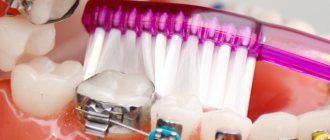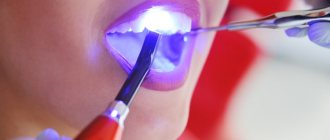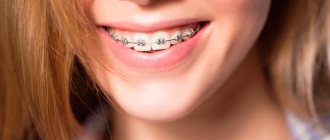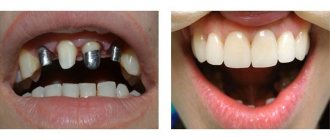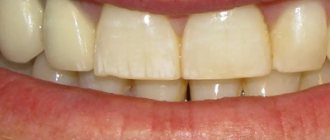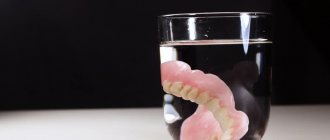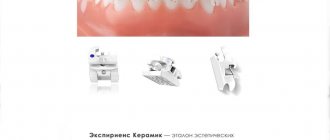Quite often you can encounter negative reviews about the treatment of occlusion with braces, which indicate the so-called “pitfalls” of wearing an orthodontic structure. These negative aspects are expressed in damage to the enamel, the development of caries, and even damage to the system itself. Orthodontists do not rule out such results, but the reason for this is not the design or lack of professionalism of the doctor, but improper care of braces. How to properly take care of your teeth and orthodontic system to avoid tooth damage and system breakdown?
Five basic principles in caring for braces
After installing a brace system for adults, the orthodontist must consult the patient about the rules of caring for the oral cavity and the structure itself.
Experts identify five main principles that need to be followed:
- Frequency of hygiene procedures.
- Individual selection of special hygiene products and instruments.
- Regular professional cleaning of the oral cavity.
- Compliance with nutritional recommendations.
- Elimination of bad habits.
If the patient follows the recommendations of the orthodontist, the braces system will retain its original condition until the end of treatment, and the teeth will remain healthy.
Nutritional Features
Those who wear braces do not have to adhere to any special diet. However, a number of foods should be excluded from the diet. What not to eat with braces :
- solid foods (nuts, some varieties of apples and pears, crackers, etc.);
- viscous and sticky confectionery products (boiled condensed milk, toffee, liquid caramel);
- fibrous foods (boiled beef);
- products with natural or artificial colors (mulberries, beets, instant coffee, carbonated drinks of unnatural colors).
In addition, it is important to pay attention to the temperature of food and drinks. Food after braces should not be too hot or too cold. Moreover, you should not allow a sharp change in temperature, for example, wash down hot food with cold water. It is best to stay within the average temperature range by consuming warm foods and drinks.
How often and correctly should you brush your teeth?
Braces are a non-removable structure; therefore, it is impossible to remove them while eating. As a result, food particles can accumulate under the elements of the system, which are gradually exposed to bacteria, decompose and provoke enamel damage or the formation of tartar. If you do not take proper care of your oral cavity, not only your teeth, but also your gums can be affected. In order to keep your teeth healthy, you need to adhere to the rules of daily oral hygiene.
Tips from orthodontists: how to properly brush teeth with braces:
- With a regular toothbrush, you can clean the teeth on the side where braces are not located, as well as the surface of the molars, thoroughly cleaning the fissures.
- Using an orthodontic brush, clean the side of the dentition where the structure is fixed. Do not make fast or strong movements. The brush is held exclusively horizontally, processing plates, clasps and accessible areas of enamel.
- Pay attention to the interdental spaces. To clean them, the brush is positioned to the teeth at an angle of 45°. Hand movements should draw a “comma”.
- Using paste and a mono-beam brush, clean the tooth enamel under the structure in hard-to-reach places.
- To clean the enamel under the arch, an orthodontic brush is used, which is placed directly under the metal arch and rotated, while slightly moving the instrument up and down.
- Hygiene is completed with the use of an irrigator, dental floss and mouthwash.
You should brush your teeth with braces after every meal. If it is not possible to perform a hygiene procedure, you can use an irrigator or mouth rinse outside the home.
Getting used to braces
The hardest part will be getting used to braces. You will feel discomfort and pressure on your jaw. How long this will last depends on your sensitivity. Typically, getting used to braces takes from 3 days to 2 weeks.
- Please be patient
. One day you will get used to the braces and they will stop bothering you. It will become easier to eat, speak and brush your teeth. - If the structure cuts the inside of the cheeks
, you can cover it with special wax or silicone. - diction problems
appear , then do not worry - when you get used to it, you will begin to speak as before.
If you feel severe pain or it seems to you that some part of the structure is seriously injuring the mucous membrane, call the orthodontist. It will adjust the system, and the addiction will be easier.
You will also have to get used to braces psychologically. Don't be shy. Many people now have orthodontic systems installed. You can meet them in everyday life and among celebrities.
To prevent the period of adaptation and wearing the system from causing severe inconvenience, adhere to the recommended diet and properly care for the oral cavity and structures.
Professional teeth and braces cleaning
No matter how carefully the patient tries to follow the rules of hygiene, if there are braces in the mouth, plaque may remain in hard-to-reach areas (back teeth, interdental spaces, areas under plates and ligatures, etc.), which can lead to caries, which will only be discovered after removing the system.
To avoid such “side effects”, it is necessary to visit the dental office every 4 months to have your teeth professionally cleaned. When wearing an orthodontic structure, dentists recommend performing the procedure using the Air flow method.
The essence of the procedure is to treat all teeth and elements of the bracket system from plaque due to exposure to air pressure with microparticles of soda. The procedure is suitable for all types of braces, including sapphire and ceramic systems.
Air flow is a method of high-quality oral hygiene that does not damage the structure and does not cause damage to the gums and enamel. The method is suitable for patients with sensitive enamel and a tendency to allergies.
Elastic bands for braces (traction)
Elastic bands for braces or traction are elastic rings that create additional load and reliably fix the arches to the braces, speeding up treatment.
There are several types of traction.
- Elastic
- rings that are put on braces installed on both the upper and lower teeth. The patient can change them himself. - Ligature rings
are small in diameter rings that are installed on each bracket to combine the plates with the arch into a single structure. - Chain rings
- they are connected alternately to form a chain. They are placed to eliminate wide interdental spaces.
What you need to care for braces
To care for braces, a personal consultation with an orthodontist is required to determine individual oral care products. Features of tooth enamel and installation of the structure, material of the system and other nuances that should be taken into account when choosing tools and tools for carrying out the correct procedure.
Products for the care of teeth and braces.
- Toothpaste. In the first 14 days, the use of paste containing fluoride or calcium is not recommended. Subsequently, regular toothpaste is selected taking into account the individual characteristics of the enamel. Pastes containing xylitol, which has a strengthening effect on enamel, are recommended.
- Foams, gels. These are special products used to clean orthodontic structures. They penetrate between and under elements more easily and also have antibacterial properties.
- Rinse aids. Any solution is suitable for rinsing the mouth if you have braces, but it is advisable to give preference to antibacterial agents.
Tools for cleaning braces and teeth.
- A regular brush for cleaning teeth from the side where the structure is missing.
- Orthodontic brush. This is a special accessory with V-shaped bristles. Used to clean teeth structures and enamel.
- Mono-beam brush. There is only one small beam on the brush, with the help of which individual elements of the system are cleaned.
- Dental brushes. The use of a brush is considered mandatory, since other accessories do not clean the arc and small spaces under structural elements poorly.
- Floss (dental floss). It is used regularly to clean the interdental spaces and areas between the plates and the arch.
- Irrigator. A device for delivering an antiseptic, refreshing or anti-inflammatory solution in a small stream to remove food particles from hard-to-reach places and soft plaque on enamel.
All of the listed products and tools are recommended to be used in accordance with the rules for caring for braces. When the regular procedure becomes habitual, it will no longer seem so difficult, and the result of high-quality care for braces will live up to expectations.
How to properly glue wax to braces
Wax for braces helps reduce discomfort and pain, saving mucous membranes from chafing. It is harmless to the body and does not cause allergies. In addition to wax, special silicone is used to care for braces. It holds better, lasts longer than wax and is also safe.
To apply wax or silicone correctly, follow the instructions.
- Identify
all problem areas. - Clean
thoroughly . - Dry
the area where silicone or wax is applied. - Cut
or tear off a small piece of silicone or wax. - Warm
a little and roll it into a ball. - Attach
the ball to the orthodontic archwire or clasp that is causing pain - the wax should protrude slightly in front of the brackets. - Press
well on the ball to secure it firmly. - Repeat
this on all problem areas. - renewed
during the day .
If you accidentally swallow such wax or silicone, nothing will happen, but it is better not to do it.
How to eat
There is no need to follow any diet while wearing braces. To maintain the original state of the system, especially if ceramic or sapphire plates are installed, only minor restrictions must be observed.
Dentists recommend avoiding the intake of hard, hot, cold, “sticky” foods, and also limiting the consumption of any products containing not only artificial, but also natural dyes. If the system is ceramic, it tends to easily absorb the coloring pigment. Avoid such bad habits. Smoking contributes to the deposition of plaque and darkening of the enamel/plates, and the habit of gnawing on something can lead to damage to the structure.
Taking care of braces and teeth is not difficult. You should be aware that neglect can lead to the development of caries or damage to the system, which will require additional material costs.
METHODS AND MEANS USED
Wearing braces for a long time is accompanied by changes in oral hygiene. In addition to the usual brush, the arsenal of hygiene products is enriched with brushes, irrigators, and floss.
For people who have not encountered such a procedure before, these words may mean nothing. Those who wear such designs know a lot about these hygiene products, but still, you need to choose them correctly.
Special toothbrushes
V-shaped brushes are considered one of the most effective and popular hygiene products. They differ from the standard ones in their shape and length of the fibers. A V-shaped brush has short bristles in the central part and long bristles on both edges.
This arrangement makes it easy to remove food debris and plaque in the interdental space. The short pile actively cleans the clasps of the orthodontic structure.
This arrangement of the bristles on the brush allows you to remove plaque quickly and without discomfort without any extra effort. The process of cleansing the oral cavity using a V-shaped brush consists of the following steps:
- Before the procedure, you need to remove the traction bands and rubber bands.
- The outer and inner parts of the tooth must be treated with sweeping movements.
- Clean the locks of the structure only in a vertical position.
- Special attention should be paid to the direction of the brush. It should be directed from the gums to the edge of the teeth.
- Using horizontal movements, you need to clean the orthodontic arch.
It is better to finish cleaning by rinsing your mouth.
Mono-beam brushes
This type of brush is specially produced with a long handle and a small head, on which only one tuft of bristles is installed. The shape of the beam can be either evenly cut or sharp.
The purpose of such a brush is to remove plaque in the interdental space. Special attention should be paid to the hardness of the pile.
It is divided into soft, medium and hard types. The process of treating the oral cavity with this method consists of several stages:
- Removing rods and rubber bands.
- The brush should be held at a right angle to the teeth.
- First treat the gum line, and then smoothly move to the interdental area.
- Afterwards you can start cleaning the locks. To do this, use the brush in smooth circular movements.
- The arch of the orthodontic system should be worked only along horizontal lines.
Cleaners
A brush is a handle-holder that consists of a metal rod. Nylon pile is woven into this rod. Only the head is considered the working area. It can have either a cylindrical or cone-like shape.
The consumer himself decides which form is more convenient for him. As for the bending angle, shape and length, the manufacturer independently selects these characteristics of the brush.
The main task of this product is to clean the interdental space and parts of the system. To properly clean the oral cavity, you need:
- hold the brush at a right angle to the teeth;
- movements should be soft and smooth so as not to damage the gums;
- After cleaning the interdental space, you can begin to treat the sides and canals;
- to clean the arch of the orthodontic system, the brush must be held parallel to it, while the brush must be constantly rotated;
- According to the 4-point principle, plaque is removed from all locks.
When braces are just installed, it is better to purchase a soft or medium-hard brush so as not to damage the gums.
Irrigators
An irrigator is a specialized device that removes plaque using a thin stream of water. Water is supplied under pressure from a separate tank. Often it is built directly into the handle of the irrigator.
Beginners need to remember that treatment of the oral cavity with this device is carried out only after classical brushing using toothpaste.
When classic cleaning is done, conditioners or boiled water can be poured into the tank. The poured liquid must be directed from top to bottom, and the pressure must be increased gradually.
Flosses
Floss is an orthodontic thread that is intended for cleaning not only the interdental area, but also the very elements of the braces. Floss is appropriate to use at the final stage of plaque removal.
For the process to be effective, you need to follow the flossing technique:
- Cleansing is done with progressive movements.
- The thread should be pulled tightly using the thumb and index finger of the left and right hands. Keep each end of the thread separately.
- Movements should be careful and smooth so as not to injure the delicate surface of the gums or catch the elements of the system.
Professional cleaning
Those who wear braces need to remember that professional cleaning should be carried out at least once every 6 months. This frequency allows you to protect your teeth from the negative effects of deposits.
The dentist may offer several cleaning options. Ultrasonic treatment and Air Flow methods are considered the most effective.
The Air Flow method is used after special staining of the surface of the teeth. A pink dye is used, which concentrates in areas of deposits. It is easier for the dentist to identify the accumulation of stones or plaque.
Air Flow is a nozzle through which a soda solution is released under pressure. Plaque removal occurs gently and without injury.
This method can be used even in areas under braces, but the ultrasound method cannot be used close to the elements of the system. The Air Flow method carries out hygiene under the arches, directly at the edge of the tooth near the gums, around the elements of the system.
Toothpaste
The health of the oral cavity depends on the quality of toothpaste, so this product must perform several functions:
- remove plaque efficiently,
- prevent deposits throughout the day,
- protect against caries,
- relieve inflammation,
- strengthen with fluorine and calcium.
Wearing an orthodontic system with improper hygiene can trigger the development of caries. To prevent this from happening, you need to:
- The paste should contain fluorine, calcium, amino fluoride, and tin.
- Fluoride-containing paste (Parodontax, Sensodyne) begins to react only 5 minutes after prolonged contact with saliva.
- Calcium paste is safer (Splat, ROCS, New Pearl).
- It is better to avoid highly abrasive pastes, as they can damage the enamel.
- It is advisable to give preference to pastes with plant enzymes.
In addition to choosing a toothpaste, you also need to properly perform oral hygiene.
To do this you need:
- brush your teeth for at least 3-5 minutes;
- brush each tooth for at least 10 seconds;
- refuse products with dyes;
- Do not consume viscous, stringy and hard foods;
- rinse your mouth after every meal;
- effectively and gently clean the interdental space.
Mouth rinses
Rinses act as additional removal of plaque and food debris. They are best used after every meal and cleansing.
In order for plaque to be removed correctly and in a timely manner, it is necessary:
- use at least 20 ml of product at a time;
- rinse without interruption for 30 seconds;
- during the rinsing process, you can also treat the throat;
- spit out the used product;
- It is better to use floss before the procedure.
To choose the right rinse aid, you need to pay attention to the composition of the product (it is undesirable for it to contain dyes).
Also, the chosen remedy should fight bacteria and relieve gum inflammation. A mandatory aspect of choosing a mouthwash while wearing braces is the absence of alcohol in the composition.
Nutrition after installation of braces
After the correction of the bite and dentition has been started, and the orthodontic system is installed, each patient must take care of his diet. In order for your teeth to remain strong and healthy, you need to include in your diet foods with a high content of nutrients, minerals and trace elements such as: calcium, magnesium, vitamins (especially C and D), fluorine, phosphorus, proteins, etc. .
Regular consumption of milk, dairy products, eggs, seafood, citrus fruits, vegetables, herbs and dishes based on them will help achieve excellent dental treatment results.
Wearing braces imposes certain restrictions on those products that can disrupt the system and interfere with the straightening of teeth. Orthodontic patients should avoid:
- solid food that can change the tension of the arcs (nuts, crackers, apples, tough meat, etc.) and cause damage to the device;
- products with high viscosity that can get stuck in braces (sweets, especially toffee, chocolate, chewing gum, etc.);
- sweets that contribute to the development of caries (marshmallows, jam, baked goods, etc.);
- drinks with dyes that can stain plastic and ceramic braces (coffee, tea, soda, etc.); you should also not consume fruits and berries with strong coloring properties (grapes, cherries, chokeberries, etc.).
Otherwise, nutrition during the period of orthodontic treatment can remain normal.
Avoid improvised means
If you don’t have a brush or toothpick at hand, you shouldn’t try to remove a stuck piece of meat with a straightened paper clip or needle. This is dangerous both for the braces system and for your own health. You can use special dental floss. When wearing a non-removable structure, its tip can be placed under the arch. Such cleaning requires care, otherwise you can tear the arc out of the grooves.
This is how you floss your teeth if you have braces.
What should you not eat while wearing braces?
The second most popular question concerns the diet during bite correction. Everything here is quite simple - you should limit those foods and drinks that can damage the brace system.
First of all, this is tough and solid food. Avoid chewing nuts, apples and other fruits and vegetables. It is also better to limit hot drinks, replacing them with warm ones. As for sweets, braces prohibit sticky toffee, which can get caught in the clasps and break them. Remember that after each use of sweets you need to brush your teeth or rinse your mouth. This will protect you from caries and allow you to occasionally treat yourself to sweets and chocolate.
Recommendations
You can increase the effectiveness of this procedure if you follow certain recommendations:
- It is most convenient to cleanse in front of a mirror . This way you can track every movement and direction of the thread.
- Before using floss, it is recommended to clean with a special orthodontic brush .
Its bristles have a V-shaped cut, where the short central bristles efficiently process the surface of the braces, while the long outer bristles remove plaque from the enamel. - When pulling the floss under the arc, you should try not to touch its surface , as the fibers can catch on the structure and lead to its deformation or breakage.
- It should be borne in mind that the cleaning procedure with braces will be much longer than without them.
- To make it easier to position the floss under the orthodontic appliance, It is recommended to use a special device - a dental floss threader.
It is a small plastic structure that looks like a needle.During use, the tip of the floss is inserted into the eye of the threader, in the same way as a regular thread is inserted into a sewing needle. Then, the threader is pushed under the wire arch of the bracket system, while simultaneously pulling the floss under it.
After this, the thread is released from the auxiliary device and cleaned in a standard manner. The threader is used to clean each segment. This will speed up the procedure and more accurately position the floss.
- During the procedure, do not put too much pressure on the surface of the tooth when removing plaque, as this can damage the enamel.
- If, after the first application of floss, small drops of blood appear on the gums without painful manifestations, do not panic .
After a few days of daily use, gum bleeding will stop. If this does not happen, and the gums continue to bleed, you need to seek help from a dentist. - If a child wears braces, then cleaning should take place under the supervision of the parents . For young children, it is advisable for parents to thread the thread under the orthodontic structure themselves.
Which irrigator for braces should you choose for quality care?
Detailed description of dentin dysplasia.
Let's discuss the Mershona apparatus https://orto-info.ru/sistemyi-vyiravnivaniya-zubov/lechebno-profilakticheskie-apparatyi/mershona.html via the link.
Cleaning before braces: why is it needed?
Correction of the bite always begins with sanitation of the oral cavity. In addition to treating diseases of the teeth and gums, it includes mandatory professional cleaning before installing braces. The doctor will remove hard deposits with ultrasound, and soft deposits with a thin and powerful jet of cleaning powder solution (AirFlow technology). After this, the teeth will need to be polished with a special paste and coated with a fluoride-containing preparation to strengthen the enamel. Such a hygienic procedure should be carried out 3 - 5 days before installation, but no later than 24 hours.
What happens if you don’t brush your teeth before braces? Bacterial plaque will get under the elements of the system, in particular under the clasps that are glued to the enamel. Considering that orthodontic appliances are worn for a year at best, and two years on average, microorganisms will have enough time to multiply and lead to the formation of caries. It is impossible to properly cure it with braces on the teeth. There is a risk of early removal of the device, and this will spoil the final result, and the patient will waste money, time and moral strength. This is why brushing your teeth before getting braces is mandatory.
